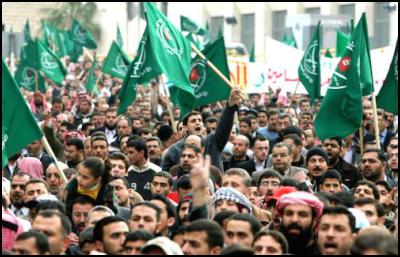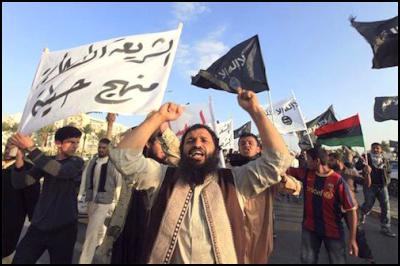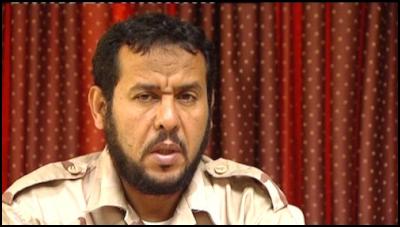The nightmare we called the “Arab Spring”
The nightmare we called the “Arab Spring”
by Nureddin Sabir
November 22,
2014
www.redressonline.com/2014/11/the-nightmare-we-called-the-arab-spring
The so-called “Arab Spring” has turned into a deep winter and a recurring nightmare from which there appears to be no escape.
With the exception of Tunisia – the cradle of the “Arab Spring” – which has settled into a precarious stability after the elections of November 2014, everywhere else is in political turmoil or bloody conflict.
In Egypt, the hope and euphoria unleashed by the 25 January 2011 revolution have been well and truly dashed, thanks to the Muslim Brotherhood’s push to monopolise power and turn Egypt into an Islamic state, and the backlash this has produced.
Yemen is in turmoil, and now more than ever is teetering on the brink of civil war, with Sunni tribes and al-Qaeda terrorists on the one hand and Shia rebels on the other vying for power, and southern secessionists wanting out altogether.
But nowhere is the tragedy of what can now be described as the Arab Nightmare more stark than in Syria and Libya, both engaged in an orgy of cannibalism and on the brink of extinction.
Blinded by wishful
thinking
How did we Arabs get it so wrong? Are
we so ignorant of the reality of our societies? Or did we
miss the signs in a haze of wishful thinking, blinded to the
obvious nightmare staring at us from the precipice to which
we were headed?
The simple answer is yes to both questions. For many educated, forward-looking Arabs a combination of detachment from reality and a form of cognitive dissonance – blocking out information that conflicts with our existing beliefs, ideas or values – were key in creating an illusion that the “Arab Spring” was an explosion of popular yearning for freedom, justice and democracy.
For one thing, Arab expatriates living in the West who had lost touch with social developments in their own countries persuaded themselves that the embers of unrest ignited in Libya and Syria by events in Tunisia were the start of a progressive revolution.
Worse than this is the fact that others, ourselves included, chose out of frustration with the stagnation and corruption of the Arab regimes to believe that, somehow, the “Arab Spring” would usher in freedom, the rule of law, justice and democracy, despite the fact that there were no significant democratic movements in at least two of the countries affected by the unrest, Syria and Libya.
As a result, we – the expatriates and others who should have known better – ignored the big monster in the room, a monster so ugly that we preferred to look the other way, lest it spoil the party. That monster was the far-right Muslim Brotherhood – the darling of many Western liberals and leftists and the cesspit from which the jihadist microbes of Ansar al-Sharia, Ansar Bayt al-Maqdis,“Islamic State” and others are nurtured and released to infect and destroy all semblance of civilisation.
Syria
In Syria, the
reality of the uprising against Bashar Assad’s Baathist
regime was blurred and distorted by a combination of wishful
thinking and the left-leaning expatriates’ disconnect from
reality – a disconnect that prevented them from
appreciating how much of a fertile ground for Islamists
Syria under the Baathists had become. Inconvenient
historical facts were blocked in the minds of the wishful
thinkers, who preferred to imagine that the mass
demonstrations against Assad were spontaneous, progressive
and desiring nothing more than a modicum of democracy and
civil liberties.
Consequently, a crucial fact of modern Syrian history was ignored. That is, since independence there have been just three drivers for regime change: the armed forces, the Baath party and the Muslim Brotherhood. There have never been vibrant and independent civil society organisations in Syria and, therefore, there has never been genuine, non-state-sponsored mass mobilisation and, in consequence, there have never been independent mass movements driving political change.
Clear signs that things were not what we wished them to be were there for all to see, but we refused to acknowledge them, preferring instead to imagine a brighter reality that did not in fact exist. The peaceful demonstrations against the Assad regime that started in 2011 were in all likelihood orchestrated by the Muslim Brotherhood. If that were not so, then who did organise them? It is inconceivable, given the scale and geographical spread of the demonstrations, that they were spontaneous and unorganised. When the regime’s brutal response to the peaceful protests triggered a steady stream of defections from the army and the peaceful demonstrations gave way to an armed insurrection initially led by the Free Syrian Army (FSA), we wanted to believe that the armed rebels were freedom fighters motivated by a desire to protect the peaceful protesters and replace the Baathist dictatorship with a democratic system that respected citizens’ civil liberties, but the facts – facts that we chose to ignore – spoke otherwise.

The Muslim Brotherhood are likely to have played a major part in instigating the unrest in Syria
Take for instance this interview, broadcast by Aljazeera TV in June 2013 – less than two years after the start of the armed insurrection – in which commanders from six rebel armed groups, including the FSA, expressed ambivalence or opposition to a democratic alternative to the Assad regime and supported the imposition of Sunni supremacy and Islamic Sharia law on the Syrian people. Their vision for Syria’s future either coincided with that of the Muslim Brotherhood (the FSA), or was more akin to that of al-Qaeda (the other five groups). Not one of the six groups wanted democracy and civil liberties, or envisioned a future for Syria that was less brutal than Assad’s rule.
Another sure sign that the picture in Syria was not the one we wished to see was the abject failure of the political opposition – the self-appointed representatives of the Syrian people – to agree on anything, much to the despair of their would-be Western supporters. For the three main political umbrella groups – the exiled National Coalition for Syrian Revolutionary and Opposition Forces and the Syrian National Council, and the internal, regime-tolerated National Coordination Committee – hatred of the Assad regime was not enough to overcome their hatred of one another. Of the three, only the National Coordination Committee had any commitment to democracy and tolerance, and for it the domination of the other two groups by the Muslim Brotherhood, with its commitment to Sharia law and government by religious scholars, was a showstopper preventing cooperation and joint action.
Libya
The catastrophe that is
Libya is an even starker example of the triumph of delusion
and wishful thinking over rational analysis – and we admit
that we were as guilty of this as anybody. The brutality
with which Muammer Gaddafi’s regime responded to the start
of the unrest in February 2011 – and his promise of untold
bloodshed in the city of Benghazi – prevented us from
assessing the Libyan situation on the basis of the true
reality of Libyan society which we knew.
Thus, just three days after the start of the Libyan unrest, on 20 February 2011, explaining why it took us so long to turn against the Gaddafi regime despite years of repression and corruption, we wrote:
For many
years, the choice was Gaddafi, the Islamists or the
ultra-reactionary, super-rich monarchists. There were no –
and as far as I am aware, there still are not – any
significant, progressive, democratic Libyan opposition. For
many years, therefore, my choice had to be Gaddafi, warts
and all.
“There were no – and as far as I am aware, there still are not – any significant, progressive, democratic Libyan opposition” – that is the truth that should have contained our emotional response to Gaddafi’s brutality and maintained our sobriety in those painful but heady days. Indeed, from the outset Gaddafi had blamed the Islamists for the protests against his regime. Although he was totally right, by that time he had become an embarrassing eccentric and the butt of jokes the world over and few people took him seriously.

Demonstrators in Benghazi display al-Qaeda’s flag at a rally shortly after the fall of Gaddafi
We did not have to believe Gaddafi to know what was happening in Libya. We knew, thanks to WikiLeaks’ exposure of a secret cable to the State Department from the US embassy in Tripoli in 2008, that eastern Libya was rife with jihadist sentiment and that many eastern Libyans, particularly those in and around Derna, appear to take pride in the “ability of radical imams to propagate messages urging support for and participation in jihad”.
There was no shortage of other evidence indicating that the Libyan rebellion was not what we wished it to be. We ignored the evidence and proceeded on the basis of the unfounded hope that Libyans were ready and equipped to embark on a journey towards freedom, justice and democracy.
The first to raise the alarm was Admiral James Stavridis, the American commander of NATO, who in March 2011 told the Senate Armed Services Committee that potential “flickers” of al-Qaeda and Hezbollah elements had been seen in intelligence regarding the Libyan opposition, which was poised to take power in the event of Gaddafi’s fall. He was right about al-Qaeda but wrong about the Lebanese Shia group Hezbollah – there are no Shia in Libya and, in any case, Hezbollah was allied to Syria, which backed Gaddafi. Stavridis’s remarks were echoed by a senior US counterterrorism official, who spoke of “a sprinkling of extremists to perhaps include al-Qaeda” among the anti-Gaddafi rebels.
Four months later, in July 2011, came the ominous murder of General Abd-al-Fattah Yunis, a former ally of Gaddafi who had defected to the rebels, by members of an Islamist militia. It was the forerunner to the serial murder of military and security officials and human rights activists by Islamist cutthroats, which continues to this day.

Abdelhakim Beljaj – key rebel commander and co-founder and emir of the jihadist Libyan Islamic Fighting Group
Then, in August of the same year, the familiar face of Abdelhakim Belhaj, known to jihadist cutthroats as Abu Abdallah al-Sadiq, entered the scene as the head of the Tripoli Military Council, the rebel group fighting Gaddafi’s forces in the Tripoli area. A former emir and co-founder of the al-Qaeda-affiliated Libyan Islamic Fighting Group, which was crushed by Gaddafi in 1998, he had fought with jihadists in Afghanistan, before worming his way back to Libya in the early 1990s and eventually escaping to Thailand and Malaysia, from where he was extraordinarily renditioned back to Libya in the early 2000s.
Other, smaller signs should have disabused us of our illusions about the “Libyan revolution”, but we preferred the dream to the grim reality. For example, in the short video clip below from the Libyan war, taken from an Aljazeera report on a group of rebel fighters called Al-Bayda Martyrs’ Brigade, Arabic speakers will notice two things: first, that members of the group are listening to recordings coming from a speaker in the back of a camouflaged pickup – recordings produced by al-Qaeda – and, second, that the conversations around the truck suggest that these particular Libyan rebels were driven by a radical agenda and religious fervour.
Anti-Gaddafi rebels listen to al-Qaeda motivational song
Other small but telling signs included the mass appearance of the old monarchist flag at anti-Gaddafi protests right from the outset of the unrest in February. This flag was totally banned under the Gaddafi regime – its mere appearance would result in the disappearance of whoever possessed it or was in close proximity to it. For this flag to suddenly be found in large numbers at every protest suggests a level of organisation. But who was doing the organising? There were no civil society bodies in Libya – none whatsoever – and Libyan society is characterised by chronic chaos – indeed, we would go as far as to say that chaos is an integral part of the Libyan psyche. This leaves only one group, the Muslim Brotherhood, the cesspit of all jihadists and Islamists in Libya.
Although the Libyan Muslim Brotherhood is small and generally despised, it is well organised, and we know from what is happening now in Libya that it is running the show. It is doing so literally at the point of the gun through its “Libya Dawn” militias in the west and the al-Qaeda- and “Islamic State”-affiliated armed groups that come under the Brotherhood’s Islamic Shura Councils in the east.
In Libya, al-Qaeda and “Islamic State” militias are seen as the strike forces of the Muslim Brotherhood
Their chief ideologue is Sadiq al-Gheriani, appointed “mufti” by the Muslim Brotherhood-dominated but now defunct General People’s Congress – the former parliament which the Brotherhood managed to dominate only by putting up candidates that concealed their true political affiliations and stood in the 2012 election as independents. In the video below in Arabic, he urges voters in the latest, 2014 legislative elections to the new parliament, the House of Representatives, to vote for the Muslim Brotherhood.
Libyan “Mufti” Sadiq al-Gheriani calls on Libyans to vote for the Muslim Brotherhood in the 2014 parliamentary elections (which they lost)
Conclusion
When
the dust has settled and the blood has dried, the Arab
Nightmare will go down as the biggest instance of mass
delusion in modern history.
Progressive patriots such as ourselves, sickened by the despotism and corruption of the likes of Gaddafi and Assad, sought refuge in the dream of better, democratic, just and law-governed societies. As if in a state of hypnosis, we preferred the temporary respite of the delusion to facing up to the ugly reality. That reality is one of chronic cultural backwardness, intellectual sterility and pre-historic superstition.
To a greater or lesser extent, Western governments seemed better aware of the darker forces at play in the Arab Nightmare. The US administration was initially distinctly lacking in enthusiasm about supporting the Libyan rebellion and only changed course in the face of intense pressure from its European allies, especially the French who were anxious to make up for their close identification with the regime of Zine El Abidine Ben Ali in Tunisia, when that regime was already in its death throes.
But the top prize for promoting the mass delusion and smoking mirrors of the Arab Nightmare must go the the international media, especially the pro-Muslim Brotherhood Aljazeera TV. Their focus on the tiny minority of media-savvy, Western-educated, English speaking telegenic activists and their abject failure to examine the real drivers at work in the Arab Nightmare not only reinforced our delusions, but also helped to create the momentum behind the NATO intervention in Libya and the confusion over what was happening in Syria.
The international media unwittingly concealed the Islamist nature of the Arab Nightmare by focusing exclusively on the tiny minority of media-savvy, Western-educated, English speaking activists
After years of dictatorship, corruption and arbitrary rule, the sad reality is that the Arab peoples are not ready for democracy.
We often mock Americans, Britons and other Westerners who, when they can be bothered to vote at all, cast their ballots for individuals and parties about which they understand very little and thereby put in doubt the value of their democracies.
Now, imagine patriarchal societies where significant proportions of the population are illiterate, where intolerance, misogyny and suppression of freedom are inculcated in most boys from birth, where girls are brought up to think of themselves as breeding, cooking, cleaning and washing appendages to men, and where the teaching and preaching of religion have been unchanged for more than 1,400 years.
That is the ugly reality of the Arab world today. It is not ripe for democracy, and the only revolution it is ready for is one that would take us back a millennia and a half.
ENDS


 Gordon Campbell: On Justin Trudeau’s Demise, In A Global Context
Gordon Campbell: On Justin Trudeau’s Demise, In A Global Context Ramzy Baroud: Israel Destroyed Gaza ‘For Generations To Come’ And The World Stayed Silent
Ramzy Baroud: Israel Destroyed Gaza ‘For Generations To Come’ And The World Stayed Silent Binoy Kampmark: Detained Without Charge - Eleven Yemenis Leave Guantánamo
Binoy Kampmark: Detained Without Charge - Eleven Yemenis Leave Guantánamo Ramzy Baroud: The War Criminal 'Victim' - Netanyahu’s Inevitable Fate
Ramzy Baroud: The War Criminal 'Victim' - Netanyahu’s Inevitable Fate Martin LeFevre - Meditations: From Symbolic Consciousness To Insight Consciousness
Martin LeFevre - Meditations: From Symbolic Consciousness To Insight Consciousness Binoy Kampmark: Arresting And Killing Greenies - Targeting Climate Change Protests
Binoy Kampmark: Arresting And Killing Greenies - Targeting Climate Change Protests